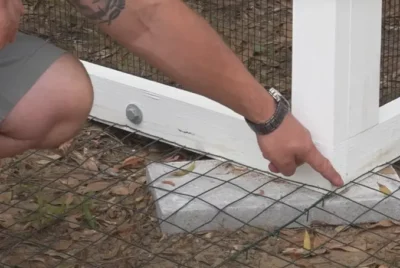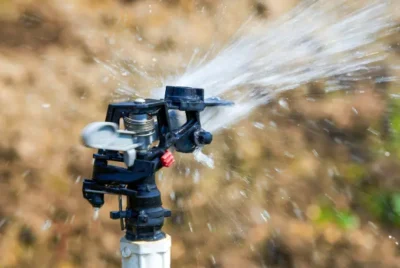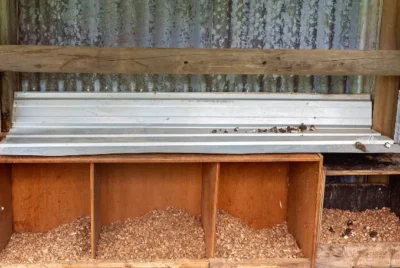How to Build a Safe Chicken Run That’s 100% Safe
Every backyard chicken keeper understands the joy of watching their flock roam freely, pecking away happily. Yet, this idyllic scene isn’t always as serene as it appears. As predators lurk and weather patterns change, the vulnerabilities of an unprotected or poorly designed chicken run become all too evident.
How can one ensure their feathery friends enjoy the freedom they deserve while staying safe from harm? The answer lies in designing and building a chicken run that’s not only spacious but also impenetrable and comfortable. Dive into our comprehensive guide to creating that perfect, safe sanctuary for your flock.
What is a Chicken Run?
A chicken run is a confined outdoor area attached to a chicken coop where chickens can roam, scratch, and peck while being protected from predators. It’s essentially an outdoor pen for chickens. It’s typically constructed using wooden or metal frames and is enclosed with wire mesh or chicken wire to ensure the chickens are kept in and potential threats are kept out.
What is the Ideal Location for a Chicken Run?
Choosing the right location for a chicken run is crucial for the well-being of the chickens and for ease of management. Here are some guidelines for locating a chicken run:
- Sun and Shade: It should be in a place that receives a good mix of sun and shade throughout the day. Chickens need sunlight for vitamin D, but also require shaded areas to protect them from the midday sun.
- High Ground: The run should be on high ground to prevent flooding during heavy rains. Chickens don’t like wet conditions, and a muddy run can lead to health issues.
- Access to Coop: Ideally, the chicken run should be directly connected to the chicken coops. This provides an easy way for chickens to move between the coop and the run.
- Away from Trees: While trees can provide shade, they can also be used by predators like raccoons or hawks as a means to gain access to the run. It’s a balance to strike.
- Ease of Access: It should be easily accessible for you for feeding, cleaning, and collecting eggs. At the same time, ensure it’s secure from potential threats.
Why Build a Chicken Run?
- Safety: A primary reason for building a run is to protect your chickens from predators. Whether it’s neighborhood dogs, foxes, raccoons, or birds of prey, many animals wouldn’t mind having a chicken for dinner.
- Health and Well-being: Chickens love to scratch, peck, and forage. A run gives them a safe space to exhibit these natural behaviors. It’s better for their physical and mental health than being cooped up all day.
- Eggs: Chickens that have access to outdoor spaces often produce better-quality eggs. The variety in their diet from foraging can contribute to this.
- Pest Control: Chickens are great at keeping pest populations in check. Whether it’s bugs, worms, or even small rodents, chickens can help control these pests.
- Lawn and Garden Protection: If left free-range without a run or chicken yard, chickens might destroy gardens by scratching up plants or eating them. A run ensures they have space to forage without ruining your vegetable garden or flower beds.
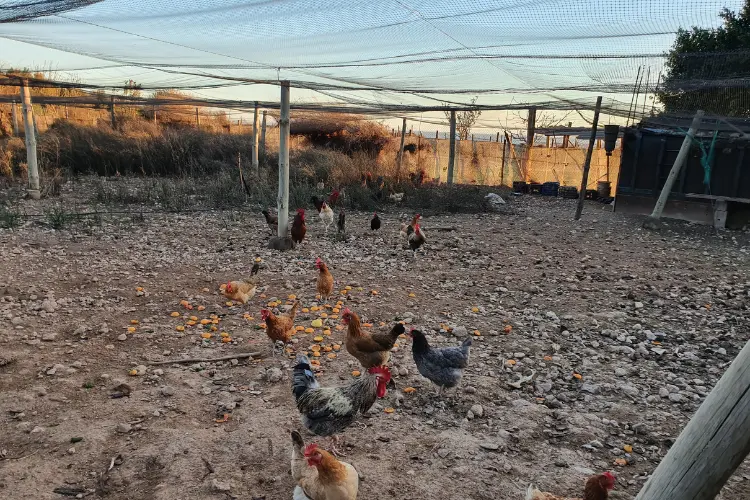
How to Build a Chicken Run
Tools
- Hammer
- Wire snips
- Pliers
- Level
- Tamper
- Posthole digger or T-post driver
- Tape measure
- Wood nails/screws
- Saw
Supplies
- Gate (or a few supplies for construction)
- Optionally: hardware cloth OR sturdy metal fencing with ½” to ¼” openings
- Optionally: robust C flex 80-round deer fencing
- Metal wire
- ¾” poultry net staples
- Zip ties
- 2×4 14 GA OR 8-10 GA welded wire fence
- Choose between 4-inch by 8-foot wooden posts, garden posts, half posts, or 7-foot T-posts.
Step 1: Outline the Appropriate Size for the Chicken Run
Before building the chicken run, you need to figure out how big it should be. This depends on how many chickens you have. A good rule is to give each chicken at least 10 square feet of space to move around in.
So, if you have 5 chickens, the run should be at least 50 square feet. Remember, more space is better because chickens like to stretch and explore. Think about how much room you have and make sure your chickens will be comfy and happy in their new space.
Helpful tips:
- Align one side of the chicken coop with the run to facilitate seamless movement between the two for your chickens.
- Incorporate a gate into your design to allow easy access to the run.
- Ensure hawk protection by designing a run around four feet in width, as the narrowness discourages hawk landings, even if there’s no overhead cover.
Read also: How Many Hens Per Rooster: The Numbers You Need to Know
Step 2: Position the Posts at Approximately Six-Foot Intervals
To start building your chicken run, you must dig holes for the posts holding the fence. To make the posts really strong, it’s a good idea to put them in concrete.
You can use a level to ensure the posts stand up straight and a measuring tape to put them a similar distance apart—about 6 to 8 feet away from each other is good.
Put the posts all around the run. Also, think about where you want to put the gate and put two posts closer together there.
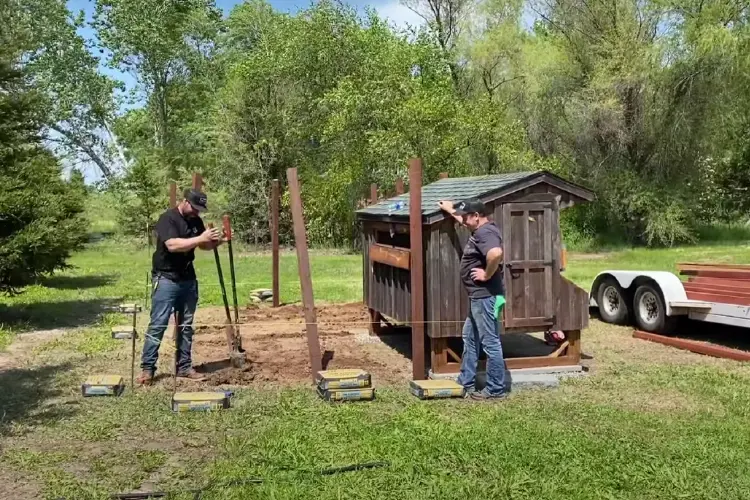
Then, use a hammer to push the posts into the holes. Ensure they go at least 1 foot deep into the ground, and about one-third of the post should be under the ground. After you’ve put the posts in the holes, cut their tops so they’re all the same height. Then, put boards across the tops to make them even stronger before you attach the fencing.
Helpful tips:
- For 7-foot T-posts, use a T-post driver or a hammer to drive them into the ground
- For 8-foot wooden posts, employ a post-hole digger to create a 2-foot hole
- Position the post into the hole, pour soil inside, and compress it with a tamper.
Step 3: Fasten the Wire Mesh to Form the Fencing
To create a safe area for your chickens that keeps predators out, it’s important to use strong wire fencing with small holes, either 1/2 inch or 1 inch in size. This kind of fencing works well to keep away not only small predators like weasels but also bigger ones like bobcats.
If you have large predators like bears around, the alternative idea is to use a special fence designed for dogs and then cover it with the smaller gauge wire. This dual layer of protection helps to safeguard against smaller predators too.

Fasten the fencing to the posts using construction staples. Once the posts are in place, attach the wire fencing to them using staples shaped like “u” and a hammer. Put these staples about every 6 inches to ensure the wire is firmly secured to the posts.
Also, make sure the wire is attached to the chicken coop itself. And remember to dig a trench around the edges of the run and bury the fencing a bit underground. This helps prevent animals like coyotes and dogs from digging underneath.
And don’t forget to cover the top of the run! This is optional but very important to stop animals like foxes, raccoons, hawks, eagles, and owls from getting inside and harming your chickens.
Step 4: Attach Hardware Cloth
In this step, you have the choice to add an extra layer of protection called hardware cloth to your DIY chicken coop. This special mesh has tiny holes that can stop tricky predators. You can attach this mesh to places where predators might try to get in, like the bottom of the run, where they might try to dig.
Use staples, nails, or ties to really make the mesh stick to the posts or your existing fence and the chicken coop. This is like a safety net that makes your chicken run even safer, preventing animals from getting through and keeping your chickens safe inside
Step 5: Construct the Framework for the Enclosure
After you’ve attached the fencing, it’s time to make a strong framework. You can use boards that are 2×4 or 1×6 inches in size. Attach these boards horizontally to your posts at the bottom, middle, and top of the fencing.
This makes everything really stable. It’s like making a sandwich – the fencing is in the middle, and the boards and posts hold it all together.
Step 6: Install a Door
When you make the door, it’s a good idea to add something called a spring. This spring helps the door close itself when you open and close it. This way, you don’t have to worry about the door accidentally being left open and your chickens won’t be able to get out.
To hang the door, use three special hinges made for doors. These hinges help the door swing open and shut. Also, put a latch on the outside of the door. This latch helps keep the door closed and ensures your chickens stay safe inside.
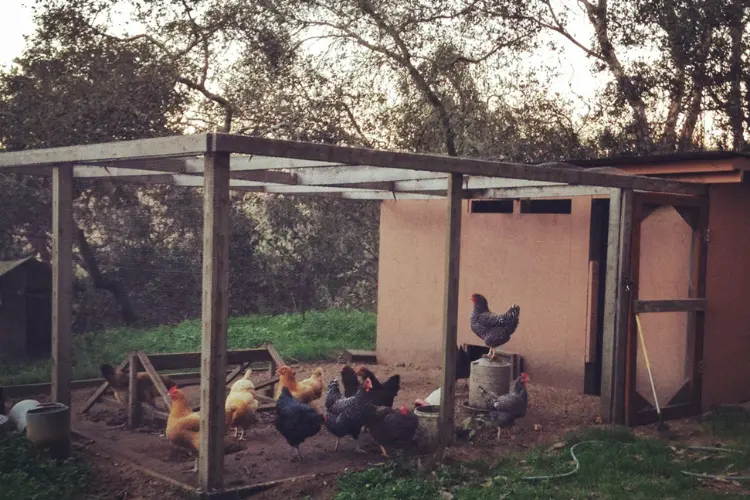
Factors to Consider When Building Your Chicken Run
When building your chicken run, several important factors should be taken into account to ensure the safety, comfort, and well-being of your feathered friends:
Size and Space
Determine the appropriate size of the run based on the number of chickens you have. Providing ample space is essential for their freedom of movement and natural behaviors.
Predator Protection
One of the ways to keep your poultry chickens from predators is fencing. So, when it comes to safeguarding your poultry, the choice of fencing material plays a crucial role. Opting for a durable welded wire with tightly spaced openings can effectively deter predators.
To enhance your poultry’s security further, think about implementing strategies such as burying the fencing and setting up an electric wire perimeter to discourage digging predators.
Framing and Structure
Building a sturdy frame using boards around the perimeter adds stability and protection. The frame can also serve as support for attaching the fencing securely.
Entrance and Exit
Install a door that’s easy for entering and exiting the run. A self-closing door with a spring prevents chickens from escaping and predators from entering.
Gate and Locks
Ensure the gate is properly secured with hinges and a latch. This prevents unauthorized access and keeps your chickens safe.
Ventilation and Shade
Ensure proper ventilation to provide fresh air circulation. Consider adding shade, especially if your run is in a sunny area, to prevent overheating.
Roosting and Nesting Areas
Designate spaces for roosting and nesting within the run. Chickens need comfortable spots to sleep and lay eggs.
Easy Cleaning
Design the run with ease of cleaning in mind. A well-designed run makes maintenance and waste management simpler.
Accessibility
Make sure the run is easily accessible for feeding, watering, and cleaning. Avoid obstacles that might hinder your daily tasks.
Integration with Coop
Ensure a smooth connection between the chicken coop and the run, allowing chickens to move freely between the two areas.
If you’re searching for designs tailored to a specific number of chickens, delve into our Best Chicken Coop for 10 Chickens review article. It offers a comprehensive look at coops that perfectly balance space, design, and functionality.
Top Cover
Consider covering the top of the run to prevent aerial predators from entering. This is especially important if you have hawks or owls in your area. You can try a single-pitch sloping roof.
Future Expansion
Think about potential future expansion if you plan to increase your flock size. Design the run with flexibility in mind.
Visibility
Ensure you can easily observe your chicken house from various points, which aids in monitoring their health and behavior
Build Your Chicken Run Now
Constructing a safe chicken run is not just about erecting a structure but ensuring the well-being and security of your poultry farm. A sturdy, predator-proof design combined with regular maintenance and vigilance can make all the difference in protecting your flock.
By investing time and effort in the planning and building phases, you not only ensure your chickens’ safety but also provide them with an environment where they can thrive and flourish.
Remember, a happy chicken is a productive chicken, and with the right chicken runs, you are setting the stage for years of fruitful raising chickens.


